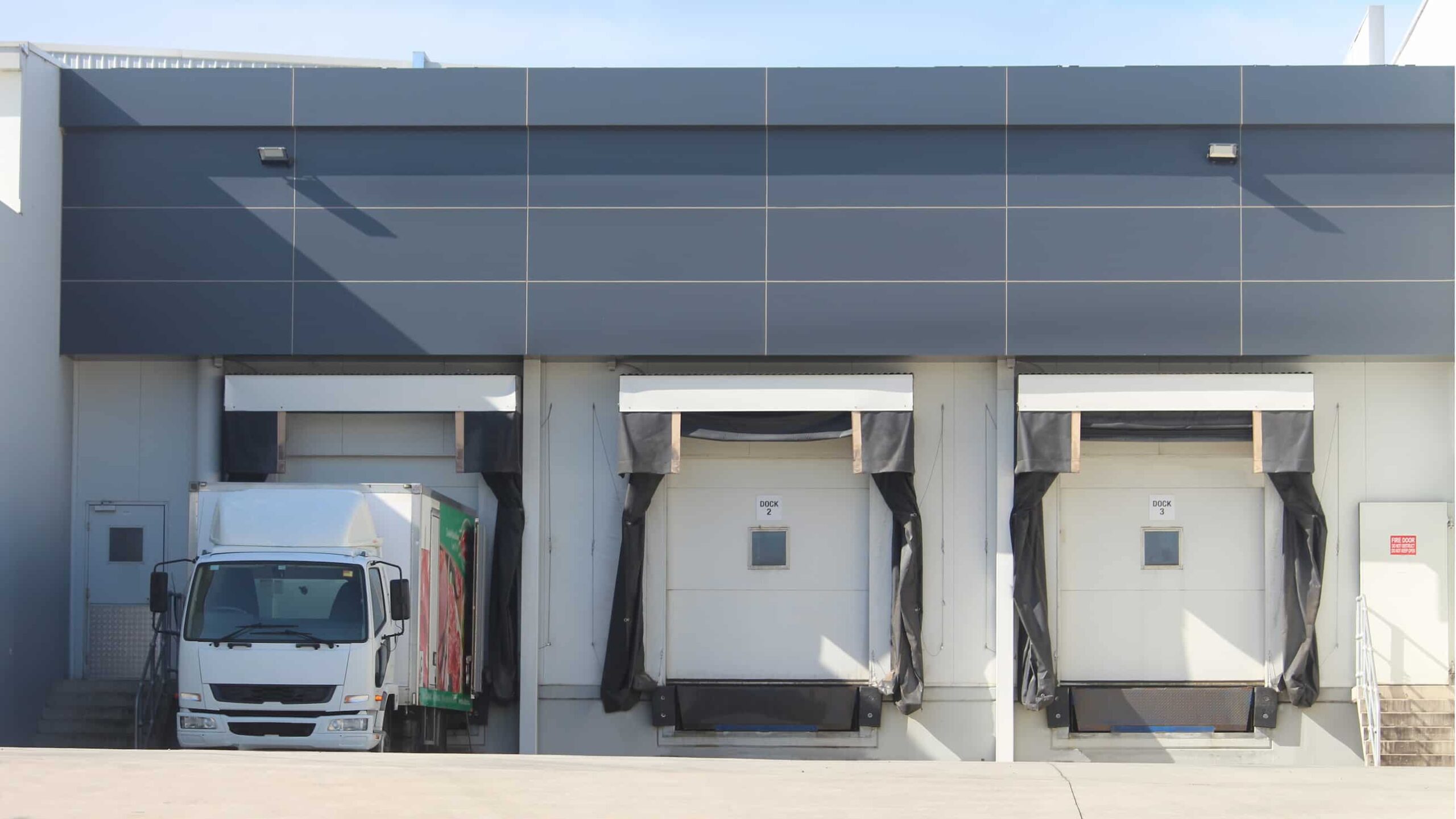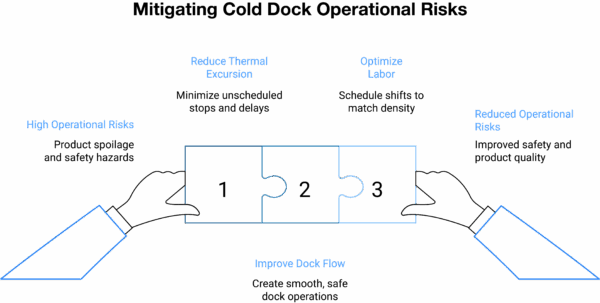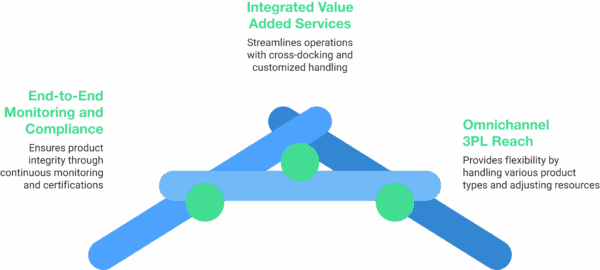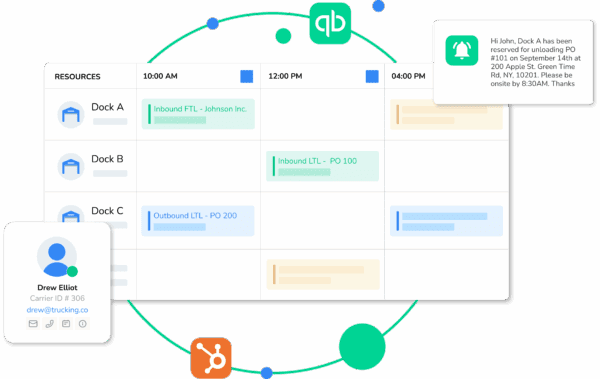
According to the World Health Organization, nearly half of all vaccines are wasted each year due to improper temperature control. This statistic highlights the importance of maintaining the cold chain at every stage, including the loading dock.
📈 The Global Graph is Surging
The global cold-chain logistics market is projected to grow up to $1.245 billion by 2033. 🔍 Read full report
As demand surges, so do the stakes. Even a few minutes of uncontrolled exposure at a cold dock can compromise product integrity, safety, and compliance. Cold-storage warehouse operators thus face acute pain points:
- Temperature and humidity spikes when doors open
- Stringent food/pharma regulations
- Chronically inefficient scheduling processes
How can cold chain teams prevent thermal shock at the dock? How do they balance tight turn-times and staging space requirements with strict traceability rules? To build a fundamental understanding of all this, we spoke with Porter Logistics, a fast-growing 3PL with deep cold-chain expertise, to understand how they manage the complexity of cold dock operations. But first, let’s explore what makes cold docks so much harder to manage than dry docks.
Cold Docks vs. Dry Docks
In cold storage facilities, the loading dock environment is fundamentally different from a dry (ambient) dock. Here are the key contrasts:
Temperature & Humidity
Cold docks must maintain refrigerated or frozen ranges (often 0°F or below). Every open door invites warm, moisture-laden air into the freezer bay. The resulting condensation and ice can impair visibility, corrode equipment, and create dangerously slippery surfaces.
Equipment & Infrastructure
Standard material handling gear won’t survive long in a freezer. Cold warehouses use specialized forklifts with heated cabins, cold-rated hydraulics, and non-freezing lubricants. Dock-leveling systems are often vertical-storing models or heavily weather-sealed to block airflow.
Worker Conditions
Working in cold environments is tough. OSHA guidelines recommend shorter shifts, more breaks, and specialized gear to protect workers. That means staffing and scheduling have to be more precise, and productivity can drop if plans aren’t solid.
Inventory Management
Because of these factors, cold-dock inventory management also differs. Products in a freezer facility carry a ticking clock (expiration dates and FIFO rotation are critical).
Why Managing a Cold Dock Is More Complicated?
The challenges above translate into higher stakes around operational metrics:
Turn Times Are Critical: Every extra minute a truck sits backed up at a cold dock costs exponentially more than in a dry dock. Cold goods degrade with each delay. A refrigerated trailer sitting off-spec, even briefly, can trigger spoilage or product recalls.
Staging Space and Throughput Constraints: Cold storage facilities often have fewer usable staging areas because they must segregate zones. Furthermore, forklift operations slow down in extreme cold, and frozen pallets require careful handling. The result is forklift cross-traffic and congestion if too many trucks arrive uncoordinately.
Regulatory and Quality Compliance: Cold-chain products (food, pharmaceuticals, chemicals) face stricter regulations than most dry goods. Requirements like FDA’s Food Safety Modernization Act (FSMA), USDA inspections, GDP for drugs, and HACCP audits all apply. Every pallet must have continuous temperature records and full lot traceability. Porter’s cold facilities maintain AIB, FDA, and GMP certifications to satisfy these mandates.
Operational Risks and the Power of Precise Scheduling
Given these stakes, operational risks at cold docks are magnified, but many can be mitigated through disciplined scheduling and visibility:
Product Spoilage: The foremost risk is thermal excursion. Every unscheduled stop, every early/late arrival, and every door open leaks cold air and shortens shelf life.
Dock Congestion and Lineups: Untamed dock queues are a safety and quality hazard. In a cold dock, those delays not only incur driver frustration and detention fees but also waste refrigerated fuel and staff time.
Safety Hazards: Slips, falls, and collisions spike when docks are chaotic. Scheduling software creates a smooth flow that significantly improves safety.
Labor Efficiency: With fixed windows, cold dock labor can be deployed more effectively. Crews can be scheduled in shifts to match appointment density, rather than idling during congestion.

Porter Logistics’ Cold Dock Strategy
Porter Logistics addresses these challenges with a holistic cold-chain approach. As an omnichannel 3PL, Porter blends cold storage in Atlanta with flexible fulfillment and transport services. Key elements of their strategy include:
End-to-End Monitoring and Compliance: Porter’s cold warehouses are designed as fully validated temperature-controlled environments. They use continuous monitoring (temperature and humidity sensors with automated alerts) to ensure products stay in spec from arrival to shipping. Their operations are certified (AIB, FDA, GMP, HACCP) to guarantee quality and food/pharma compliance.
Integrated Value-Added Services: Beyond just storage, Porter offers cross-docking, consolidation, and customized handling to streamline cold flows. These services reduce unnecessary staging time like trailers don’t idle in the dock waiting for repacking, because preparatory work is built into Porter’s process. In short, Porter treats a cold dock not as a simple door but as an active processing point that supports just-in-time cold chain operations.
Omnichannel 3PL Reach: In practice, Porter’s cold-dock strategy is bolstered by its omni-3PL model. The same cold storage facilities handle ambient, refrigerated, and frozen products, giving the ability to reallocate dock doors and labor dynamically. During peak cold season, more trailers can be funneled through the chilled docks, while dry vans are handled elsewhere.

By combining certified processes with agile services, Porter’s cold storage operation is engineered to meet the highest demands. But what ties it together is intelligent dock management.
How Technology Helps Keep Cold Docks Under Control?
To streamline its busy cold docks, Porter Logistics has implemented Arrivy’s dock scheduling software for managing dock operations. It brings automation and visibility to Porter’s loading docks in several ways:
Calendar-Based Interface: Porter’s dispatchers and carriers use an intuitive, web-based calendar to book appointments. Arrivy shows real-time availability by time slot and dock, in multiple views (daily calendar, Kanban board, list, etc.). For example, if a refrigerated door is booked in the 9–10 AM slot, other users immediately see that slot as taken, preventing double-booking. Porter can color-code slots by dock or handler, and drag-and-drop to adjust schedules on the fly.
Carrier Self-Scheduling: Rather than relying on phone/email tag, Arrivy gives carriers a secure booking link. A driver can see available slots (along with any requirements like pallet jacks or tethers) and reserve a time. This self-scheduling cuts down weeks of back-and-forth to a one-click process.
Automated Notifications: Once an appointment is booked or changed, the system sends immediate notifications to all stakeholders. A forklift operator on the dock receives a text: “Trailer arriving at Door 3, scheduled for 10:00 AM.” These alerts mean nobody is left in the dark as carriers are no longer wandering around asking.
Custom Booking Rules and Templates: Porter takes full advantage of Arrivy’s flexible rules. Static or dynamic calendars can be set up so that, for example, certain cold docks are only bookable by account (to reserve capacity for high-priority products), or longer 2-hour slots are automatically created for deep-freeze trailers.
Real-Time Dashboard and Reporting: Finally, Porter’s managers have a live dashboard of all appointments from Arrivy. They can filter by facility (Atlanta vs. Tampa), by shift, or by carrier, and instantly see the queue of inbound cold trucks. If weather causes a port shutdown or if a dock door goes down, the schedule can be rapidly adjusted.

Final Verdict
Cold storage loading docks operate at the intersection of extreme environments and high pressure. The consequences of missteps are severe, from product spoilage and wasted profit to safety incidents and compliance failures. Porter’s approach includes validated freezer facilities with 24/7 monitoring, certified quality systems, agile value-added services, and intelligent dock scheduling from Arrivy ensures that cold chain integrity is maintained at every transfer point from inbound to outbound.
